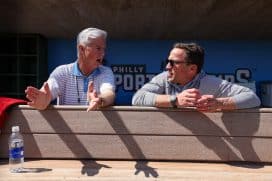Phillies
Top 25 Players to Ever Play a Game for the Phillies: No. 23, Kenny Lofton
By Matt Alberston, Historical Columnist
In 2003, the Phillies signed former Cleveland Indians slugger Jim Thome to a lucrative contract. First base was set for the foreseeable future for a promising club with prospects rising to the top of the minors. In 2005, the Phillies traded pitcher Felix Rodriguez to the New York Yankees for aging veteran Kenny Lofton, a teammate of Thome's in Cleveland. Thome told Philadelphia Inquirer staff writer Todd Zolecki after the trade, "When we got him, I was excited because there are certain guys over your career that can win games a lot of different ways. He's that guy." High praise from Philadelphia's biggest free agent signing since Pete Rose came to town in 1979.
But the Cleveland connection did not end with Thome.
In 2005, the Phillies hired former Cleveland manager Charlie Manuel to the same role. Manuel's relationship with Lofton dated back to the early 1990s, when Lofton was a Triple-A center fielder and Manuel Cleveland's Triple-A in Colorado Springs. "Manuel loved him," Zolecki wrote. "He loved how he played shallow in center; but could catch everything over his head. He loved how he ran the bases and how he hit."
Lofton was excited to join the rebuilding Phillies in 2005 after receiving limited playing time in New York, where he hit .275 with 3 home runs and 18 RBI in 83 games. Lofton formed a platoon along with Jason Michaels in 2005 and played in 110 games, slashing .335/.392/.420 while scoring 67 runs and stealing 22 bases.
Over 17 big league seasons, Lofton compiled solid career numbers, slashing .299/.372/.423 and amassed 2,428 career hits, 383 doubles, 116 triples and 622 stolen bases. He appeared on one BBWAA Hall of Fame ballot in 2013, but garnered only 3.2% of the vote and was removed from following writers ballots for failing to receive the five percent minimum.
Career Accomplishments
- Played 17 years with 11 teams
- Six-time All-Star (1994-1999)
- Four-time Gold Glove winner (1993-1996)
- Led American League in stolen bases every year between 1992-1996
- Member of Cleveland Indians Hall of Fame
- Played in 95 postseason games, including 13 World Series games
*Awards were not factored into the formula
Career Defining Moment
Lofton was the prototypical top-of-the-order hitter who played small ball and pressured defenses on the base paths. In Game 1 of the 1995 World Series, Lofton reached base on an error from Braves shortstop Rafael Belliard and proceeded to steal both second base and third base. This allowed him to score the first run of the '95 fall classic when Carlos Baerga grounded out to Belliard.
Reasoning for ranking
Lofton scored 31 total points in our formula. He totaled one of the highest career WAR totals on the list (per Baseball-Reference) with 68.2 career WAR, an average of 4.01 WAR per year. Lofton had 11 seasons of 2+ WAR and six seasons at 5+ WAR, which gave him 29 points alone. His 2,428 hits are 120th most in MLB history and his 116 triples are 108th in MLB history, adding another two points to the overall total of 31.
Between 1992 and 2000, Lofton compiled 45.5 WAR, averaging 4.55 WAR per year (5+ is considered All-Star level). He compiled 14.78 WAR over his last 9 seasons, averaging 2.11 WAR (2+ is considered a major league starter). This total was boosted by his 3.5 WAR in 2005 with Philadelphia, his highest total since totaling 5.6 WAR in 1999 with Cleveland.
Lofton scored a 1 out of 10 on our subjective importance scale because he was merely a platoon player on a team that featured budding talents Pat Burrell, Jimmy Rollins and Chase Utley. He was replaced by Aaron Rowand in 2006.
Explanation of scientific formula
The player rankings formula combines both traditional and advanced statistics/metrics and assigns a point total to each category.












































